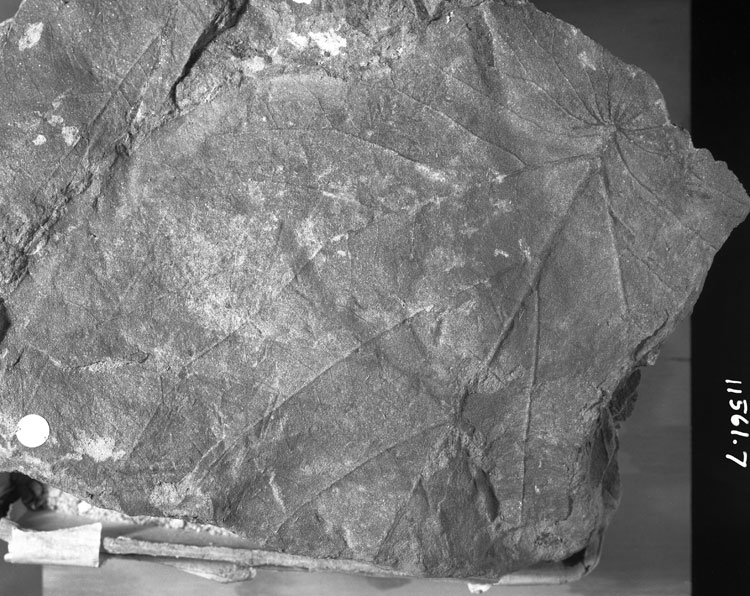Locality
Yukon-Koyukuk Basin Locality 11561
Leaf: simple; usually symmetrical; obovate; apex rounded or obtuse; base rounded peltate; margin dentate; teeth apices obtuse, sides concave, sinuses shallow rounded, median vein gradually thickening, terminating at apex in a shallow depression; primary midvein moderate, straight; pectinal veins slightly weaker than midvein, departing at 40° to midvein, very slightly curved or straight, craspedodromous, usually branching twice admedially, admedial branches weak to moderate, curved, craspedodromous; abmedial branches moderate, departing pectinal at 35-60°, irregularly curved or straight, running more or less parallel to each other, craspedodromous, branched abmedially or forked usually up to four times, branching frequency increasing basally; superior secondaries moderate, parallel to pectinals, slightly curved or straight often branched abmedially, sometimes admedially, frequency of branching increasing basally, craspedodromous; inferior secondaries moderate to weak, straight or recurved, degree of recurving increasing basally, forked once or twice, craspedodromous, usually about five pairs; tertiary veins percurrent, simmple or forked, usually convex, joining both ad- and abmedial sides of secondaries at right or acute angles; fourth order veins orthogonal, reticulate to percurrent, simple or forked.
These leaves, although all are incomplete, are very similar to specimen USGS 11561.3 (form HAPLTL14). Nevertheless, they differ in that (a) the pectinal veins give off one or more admedial branches near the margin instead of simply forking, (b) the bases are peltate rather than apparently cordate, (c) the pectinal veins tend to be straight rather than markedly curved shortly after departing the midvein, and (d) the inferior secondaries are craspedodromous instead of brochidodromous. The nature of the teeth at the base is unknown but they may well run round the base without siginificantly reducing in size as in specimen USGS 11561.1 (form HAPLP21).
All possess 'platanoid' type teeth and fall within the circumscription of the genus Pseudoprotophyllum. They may be referred to Pseudoprotophyllum magnum although the apical portion of the lamina, including the distal branching of the pectinals, is missing in all of Hollick's (1930) specimens.
